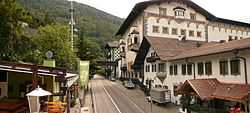Algund
| Algund | |
|---|---|
| Comune | |
| Gemeinde Algund Comune di Lagundo | |
 | |
 Algund | |
| Coordinates: 46°41′N 11°8′E / 46.683°N 11.133°ECoordinates: 46°41′N 11°8′E / 46.683°N 11.133°E | |
| Country | Italy |
| Region | Trentino-Alto Adige/Südtirol |
| Province | South Tyrol (BZ) |
| Frazioni | Aschbach (Riolagundo), Forst (Foresta), Mitterplars (Plars di Mezzo), Mühlbach (Riomolino), Oberplars (Plars di Sopra) and Vellau (Velloi) |
| Government | |
| • Mayor | Ulrich Gamper |
| Area | |
| • Total | 23.6 km2 (9.1 sq mi) |
| Population (Nov. 2010) | |
| • Total | 4,837 |
| • Density | 200/km2 (530/sq mi) |
| Demonym |
German: Algunder Italian: lagundesi |
| Time zone | CET (UTC+1) |
| • Summer (DST) | CEST (UTC+2) |
| Postal code | 39022 |
| Dialing code | 0473 |
| Website | Official website |

Algund (Italian: Lagundo) is a Gemeinde (municipality) in South Tyrol in northern Italy, located about 25 km northwest of Bolzano.
Geography
As of 30 November 2010, it had a population of 4,837 and an area of 23.6 km².[1]
Algund borders the following municipalities: Lana, Marling, Merano, Naturns, Partschins, Plaus and Tirol.
Frazioni
The municipality of Algund contains the frazioni (subdivisions, mainly villages and hamlets) Aschbach (Riolagundo), Forst (Foresta), Mitterplars (Plars di Mezzo), Mühlbach (Riomolino), Oberplars (Plars di Sopra) and Vellau (Velloi).
History
Place name
The name apud Algunde (Latin for close to Algund) appears for the first time in 994.[2]
Coat-of-arms
The emblem is a barrel of wine, overhanged by a vine-shoot of black grapes, on or bordered by an argent and gules crown gear. The barrel and grapes symbolize the viticulture practiced in the area, the argent and gules indented frame represents the membership to the Tyrol. The emblem was adopted in 1970. [3]
Society
Linguistic distribution
According to the 2011 census, 85.17% of the population speak German, 14.58% Italian and 0.25% Ladin as first language.[4]
| Language | 2001[5] | 2011[4] |
|---|---|---|
| German | 86.81% | 85.17% |
| Italian | 12.93% | 14.58% |
| Ladin | 0.26% | 0.25% |
Demographic evolution

- note: after 1921 the frazione Forst was switched from Marling to Algund.
References
- ↑ All demographics and other statistics: Italian statistical institute Istat.
- ↑ Egon Kühebacher (1991), Die Ortsnamen Südtirols und ihre Geschichte, Bozen: Athesia, p. 27
- ↑ Heraldry of the World: Algund
- ↑ 4.0 4.1 "Volkszählung 2011/Censimento della popolazione 2011". astat info (Provincial Statistics Institute of the Autonomous Province of South Tyrol) (38): 6–7. June 2012. Retrieved 2012-06-14.
- ↑ Oscar Benvenuto (ed.): "South Tyrol in Figures 2008", Provincial Statistics Institute of the Autonomous Province of South Tyrol, Bozen/Bolzano 2007, p. 16, table 10
External links
![]() Media related to Algund at Wikimedia Commons
Media related to Algund at Wikimedia Commons
- (German) (Italian) Homepage of the municipality
